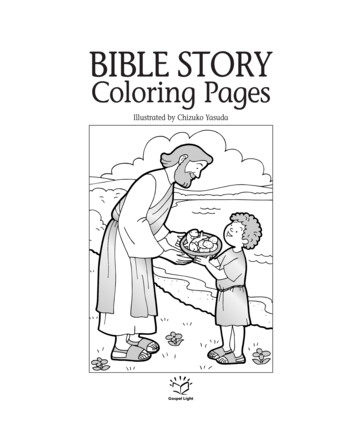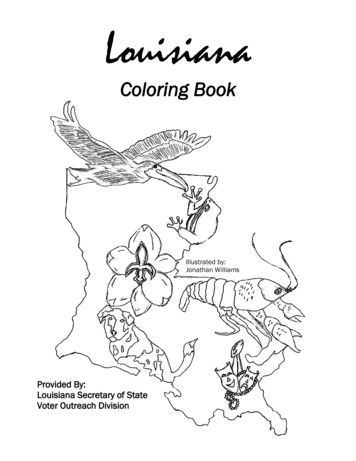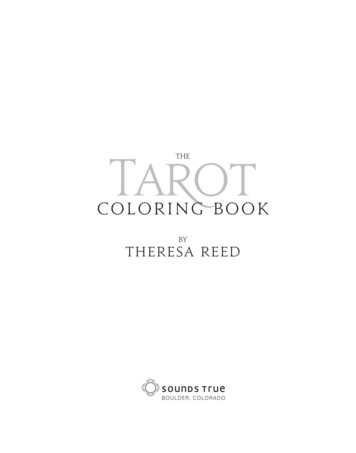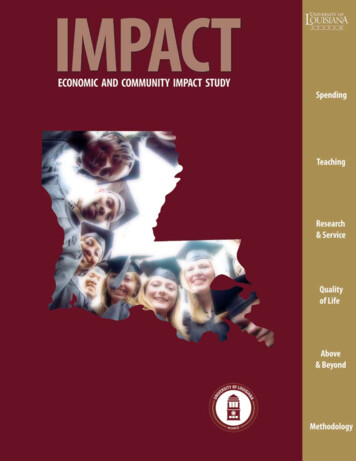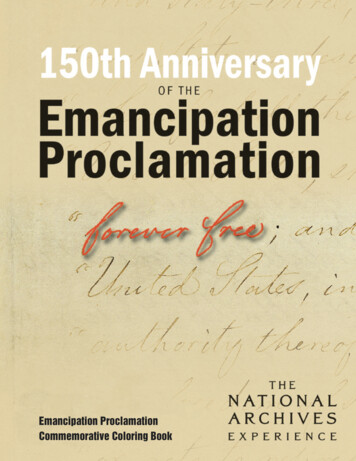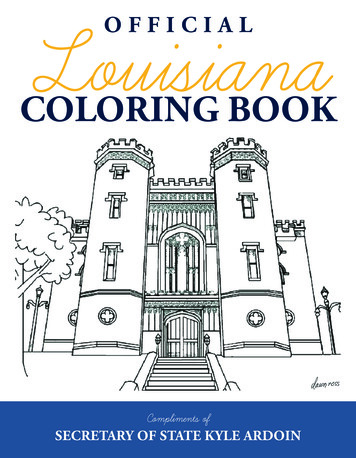
Transcription
OFFICIALLouisianaCOLORING BOOKCompliments ofSECRETARY OF STATE KYLE ARDOIN
Secretary of StateState of LouisianaR. Kyle ArdoinSecretary of StateP.O. Box 94125Baton Rouge, LA 70804-9125225.922.2880Dear student,Louisiana is a state like no other. We hold a unique place in the history ofthe United States and take pride in the many things that help to distinguishour people, the places they live and the things they cherish the most.Known for our cultural diversity, Louisiana’s rich heritage can be linkedto our official state symbols. This coloring book includes a sampling of thosesymbols and gives you a chance to use your artistic imagination to completethem. A complete listing of state symbols can be found in our LouisianaFacts booklet or by visiting the Louisiana Legislature’s website.We hope you enjoy learning and exploring Louisiana. Please feel free tocontact the Secretary of State’s Office should you need assistance in the future.Sincerely,Kyle ArdoinSecretary of State
State SealIn 1902, Gov. William Henry Wright Heard directed the secretary of state to use a stateseal of this description: “A Pelican, with its head turned to the left, in nest with threeyoung; the Pelican, following the tradition in act of tearing its breast to feed its young;around the edge of the seal to be inscribed ‘State of Louisiana.’ Over head of the Pelicanto be inscribed ‘Confidence.’” That is the seal that represents the State of Louisianatoday.
State FlagThis official flag of Louisiana is now in general use, consisting of a solid blue field withthe coat-of-arms of the state, the pelican feeding its young, in white in the center, with aribbon beneath, also in white, containing in blue the motto of the state, “Union, Justiceand Confidence.” It was adopted by an Act of the Legislature in 1912.
State Flower: MagnoliaThe large creamy-white bloom of the magnolia tree (Magnolia grandiflora) wasdesignated the state flower in 1900 because of the abundance of trees throughout thestate. The magnolia is an evergreen, and the flower is usually fragrant. After the six to 12petals of the flower have fallen away the large cone shaped fruit of the magnolia isexposed.
State Wildflower: Louisiana IrisThe Louisiana iris (Giganticaerulea) is perhaps the most magnificient of its species.Although it is adaptable to all climates, it is seen growing wild mainly in damp, marshylocations in Louisiana’s coastal areas and for perhaps 100 miles inland. This gracefulbeauty grows to a height of five or six feet and has a wider color range than any otheriris, from pale blue to deep indigo. It became our official wildflower in 1990.
State Musical Instrument: “Cajun” AccordionLouisiana’s official musical instrument, the diatonic accordion, commonly known as the“Cajun” accordion, was adopted in 1990. The diatonic accordion with a single row ofreeds and buttons was the first accordion developed. This specific type of accordion iscalled a melodeon and began to arrive in Louisiana via German immigrants during themid 1870s. Cajuns could not obtain the melodeons after World War II, and they beganto make copies of the German models themselves.
State Bird: Brown PelicanThe brown pelican (Pelecanus occidentalis) became Louisiana’s official bird on July 27,1966. It nests from South Carolina to Brazil and are famous for their large bill, thelower portion of which has a pouch which may be greatly extended. The birds use theirpouches to scoop up their food from salt water. Average consumption of a one-monthold pelican is five pounds of fish per day.
State Tree: Bald CypressHalf of Louisiana is timbered with an abundance of varied and beautiful trees, but noaction was taken to designate a state tree until 1963 when the bald cypress (taxodiumdistichum) was made the official tree of Louisiana. The cypress grows in many areas ofthe state, particularly the swampy areas.Its shape depends greatly on the amount and duration of flooding in the area and variesfrom columnar to conical or bottle shaped. The bark is reddish-brown, fibrous, thin anddivided into small, flat ridges and shallow furrows. Leaves of the cypress tree spread inflat planes in a feathery pattern on its branchlets.
State Mammal: Black BearIn 1992, the Louisiana black bear (Ursus americanus lutelous) became the state’s officialstate mammal, the same year it was listed as threatened under the Endangered SpeciesAct of 1973. Black in color, some with distinct white blazes on their chests, it is one of16 unique subspecies of the American black bear. These bears typically inhabit densewoodlands along the Tensas, Black and Atchafalaya Rivers. Today, the LouisianaDepartment of Wildlife and Fisheries works with other governmental agencies andnonprofit organizations to protect black bears in Louisiana with recent researchindicating a population of more than 500 statewide.
State Insect: HoneybeeThe honeybee (apis mellifera) is a social, honey-producing bee, recognized as the mosteconomically valuable of all insects. This reputation commonly rests on its productionof honey and beeswax. The honeybee’s greatest usefulness, however, is actually in thepollination of crops and many uncultivated plants that prevent erosion by keepingtopsoil from being carried into the ocean. The honeybee was made our official insect in1977.
State Dog: Catahoula LeopardThe Catahoula Leopard dog is the only breed of dog native to Louisiana and became ourofficial state dog in 1979. This hound is a cross of a domestic dog the Indians of theCatahoula Lake region raised and a Spanish “war dog” that came through the area inthe early 1500s. The dog has glassy eyes, webbed feet and spotted coat. Catahoulas aregentle with children, loyal to family and aggressive to strangers making them good petsand guard dogs. As a hunting dog, they are diligent, dependable, efficient and especiallygood at tracking deer, racoons and squirrels.
State Fruit: StrawberryThe 2001 Louisiana Legislature selected the strawberry as the official state fruit.Ponchatoula, located in Tangipahoa Parish, is considered the strawberry capital ofLouisiana. The annual festival attracts 300,000 festival goers to the small town of 5,000.
State Crustacean: CrawfishSouth Louisiana is the crawfish capital of the world, supporting a multimillion dollarindustry. The crawfish, in appearance, greatly resembles the lobster, but is much smaller.Its color varies with the water in which it lives and its variety.
State Reptile: AlligatorThe alligator was adopted as Louisiana’s state reptile in 1983. It lives in the waters andlow lands of the state and other locations of the southeast United States. Resemblinga lizard in shape, grown males, larger than females, reach a length of 11 to 12 feet andweigh 450 to 500 pounds. When grown, its color is dull gray and dark olive.Alligators provide better care for their young than most reptiles do, protecting theiryoung for one year or more. Once common, their numbers were reduced enough tobe classified as endangered. Regulated hunting is allowed since the designation waschanged to threatened in 1977.
State Amphibian: Green Tree FrogAdopted in 1993, Louisiana’s state amphibian is the green tree frog (hyla cinerea) andis also known as the fried bacon frog, cowbell frog and the bell frog. Green tree frogslive in swamps, borders of lakes and bayous on floating vegetation, in trees and bushesnear water, in Spanish moss or under bark on trees. They can often be found clingingon windows or window sills at night looking for insects that are attracted to light. Theycan reach lengths of up to 10 centimeters, and their color is usually green, but changesfrequently. It has a cream-colored stripe with dark borders extending along the sides anda dark stripe down the back. Besides being Louisiana’s official amphibian, the green treefrog is the basis for “The Muppets” Kermit the Frog.
State Freshwater Fish: Sac-au-laitAlso adopted in 1993, the sac-au-lait (pomoxis annularis) is Louisiana’s state freshwaterfish. The sac-au-lait, also known as white perch and white crappie, is translated fromCajun French to English as sack of milk.Two species, black and white, exist in Louisiana, often found in the same watersalthough each has specific preferences. Black crappie prefer clear, still lakes or backswamp waters while white crappie prefer the moving water of rivers and bayous.
State Saltwater Fish: Speckled TroutIn 2001, the speckled trout (cynoscion nebulosus), or spotted sea trout, was namedLouisiana’s official saltwater fish. The speckled trout is a common fish found in thesouthern United States along the coasts of the Gulf of Mexico and South Atlantic Ocean.While most are caught on shallow, grassy flats, they also live in any inshore waters.Contrary to its name, the speckled trout is not a member of the trout family, but of thedrum family.
State Vegetable Plant: Creole TomatoFor Louisianians, summer is not summer without Creole tomatoes. Named the state’sofficial vegetable plant in 2003, Creole tomatoes are relatively late to ripen, but aremeatier than other varieties of tomatoes. These tomatoes are tolerant of heat and humidity, a necessity in south Louisiana, and resist cracking. Historically, Creole tomatoes aregrown in St. Bernard and Plaquemines parishes.
State Symbol: Fleur-de-lisThe fleur-de-lis was adopted as Louisiana’s official state symbol by the Legislature in2008. Rooted in French culture, the stylized lily is used as a decorative design derivedfrom the yellow, six-petaled lillies and the way they bend. Fleurs-de-lis are commonlyused in Louisiana on apparel, in architecture and most notably, as the logo of the NewOrleans Saints.This public document is published at a total cost of 1,245.20. 1,500 copies of this public document were published in thisfirst printing at a cost of 1,245.20. The total cost of all printings of this document including reprints is 1,245.20. Thisdocument was published by OTS-Production Support Services, 627 N. Fourth St., Baton Rouge, LA 70802 to beused as a resource material under authority of special exception by the Division of Administration. This materialwas printed in accordance with standards for printing by state agencies established in R.S. 43:31. Printing of thismaterial was purchased in accordance with the provisions of Title 43 of the Louisiana Revised Statutes.
COLORING BOOK. Secretary of State State of LouiSiana P.o. Box 94125 Baton rouge, La 70804-9125 225.922.2880 Dear student, Louisiana is a state like no other. We hold a unique place in the history of the United States a
